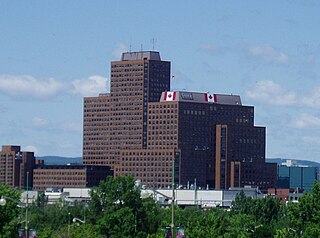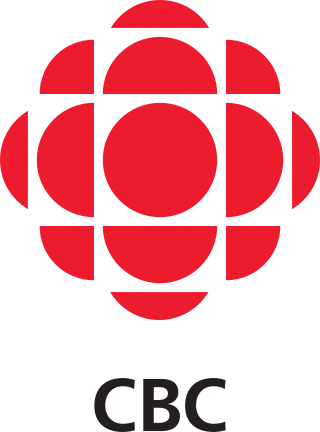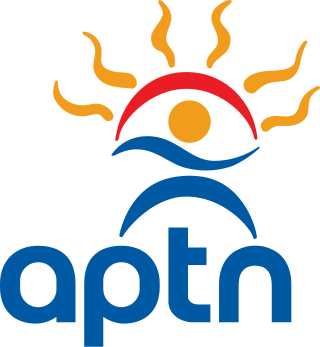
The Canadian Radio-television and Telecommunications Commission is a public organization in Canada with mandate as a regulatory agency for broadcasting and telecommunications. It was created in 1976 when it took over responsibility for regulating telecommunication carriers. Prior to 1976, it was known as the Canadian Radio and Television Commission, which was established in 1968 by the Parliament of Canada to replace the Board of Broadcast Governors. Its headquarters is located in the Central Building of Les Terrasses de la Chaudière in Gatineau, Quebec.
The CTV Television Network, commonly known as CTV, is a Canadian English-language terrestrial television network. Launched in 1961 and acquired by BCE Inc. in 2000, CTV is Canada's largest privately owned television network and is now a division of the Bell Media subsidiary of BCE. It is Canada's largest privately or commercially owned network consisting of 22 owned-and-operated stations nationwide and two privately owned affiliates, and has consistently been placed as Canada's top-rated network in total viewers and in key demographics since 2002, after several years trailing the rival Global Television Network in key markets.

The media of Canada is highly autonomous, uncensored, diverse, and very regionalized. Canada has a well-developed media sector, but its cultural output—particularly in English films, television shows, and magazines—is often overshadowed by imports from the United States. As a result, the preservation of a distinctly Canadian culture is supported by federal government programs, laws, and institutions such as the Canadian Broadcasting Corporation (CBC), the National Film Board of Canada (NFB), and the Canadian Radio-television and Telecommunications Commission (CRTC).
TVO, formerly known as TVOntario, is a publicly funded English-language educational television network and media organization serving the Canadian province of Ontario. It operates flagship station CICA-DT in Toronto, which also relays programming across portions of Ontario through eight rebroadcast stations. All pay television providers throughout Ontario are required to carry TVO on their basic tier, and programming can be streamed for free online within Canada.

The Cable Public Affairs Channel, better known by its acronym CPAC, is a Canadian specialty channel owned by a consortium consisting of Rogers Communications, Vidéotron, Cogeco, Eastlink, and Access Communications. The channel is devoted to coverage of public and government affairs, including carrying a full, uninterrupted feed of proceedings of the House of Commons of Canada, with three audio channels, one untreated feed and, with the assistance of interpreters, one in each of the official languages.

The Société de télédiffusion du Québec, branded as Télé-Québec, is a Canadian French-language public educational television network in the province of Quebec. It is a provincial Crown corporation owned by the Government of Quebec. The network's main studios and headquarters are located at the corner of de Lorimier Street and East René Lévesque Boulevard in Montreal.
CBLT-DT is a television station in Toronto, Ontario, Canada, serving as the flagship station of the English-language service of CBC Television. It is part of a twinstick with Ici Radio-Canada Télé outlet CBLFT-DT. Both stations share studios at the Canadian Broadcasting Centre on Front Street West in downtown Toronto, which is also shared with national cable news channel CBC News Network and houses the studios for most of the CBC's news and entertainment programs. CBLT-DT's transmitter is located atop the CN Tower.
CBC Television is a Canadian English-language broadcast television network owned by the Canadian Broadcasting Corporation, the national public broadcaster. The network began operations on September 6, 1952. Its French-language counterpart is ICI Radio-Canada Télé.

Shaw Broadcast Services is the division of Canadian telecommunications company Shaw Communications that is responsible for providing and managing the distribution of television channels to cable companies via satellite. Shaw Communications also operates Shaw Direct, a Canadian direct broadcast satellite service.

Television in Canada officially began with the sign-on of the nation's first television stations in Montreal and Toronto in 1952. As with most media in Canada, the television industry, and the television programming available in that country, are strongly influenced by media in the United States, perhaps to an extent not seen in any other major industrialized nation. As a result, the government institutes quotas for "Canadian content". Nonetheless, new content is often aimed at a broader North American audience, although the similarities may be less pronounced in the predominantly French-language province of Quebec.
Community television in Canada is a form of media that carries programming of local community interest produced by a cable television company and by independent community groups and distributed by a local cable company.

CFWH-TV was the television call sign for the CBC's television station in Whitehorse, Yukon. Commencing transmissions on November 26, 1968, it was one of ultimately six Frontier Coverage Package stations in the Yukon; satellite delivery of colour television began on February 5, 1973. It was a part of the CBC North television system.

Videon Cablesystems was a Canadian cable television service in Manitoba, Alberta, and for a short period, northwest Ontario. The company was owned by Moffat Communications Ltd. and Randall L. Moffat was its president.
Canada is served by various multichannel television services, including cable television systems, two direct-broadcast satellite providers, and various other wireline IPTV and wireless MMDS video providers.
TSN2 is a Canadian English-language discretionary sports specialty channel that acts as the secondary feed of sports-centred channel The Sports Network (TSN) and owned by CTV Specialty Television Inc. It was launched in its current form on August 29, 2008.
This is a timeline of the history of the Canadian Broadcasting Corporation.
The Inuit Broadcasting Corporation (IBC) is a television production company based in Nunavut with programming targeted at the Inuit population of Nunavut. Almost all of its programs are broadcast in Inuktitut. Some are also in English. IBC shows centre on Inuit culture. The company has five production centers in Nunavut, all staffed by Inuit. Founded in the early 1980s, the IBC was the first indigenous-language television network in North America.

The Aboriginal Peoples Television Network is a Canadian specialty channel. Established in 1992 and maintained by governmental funding to broadcast in Canada's northern territories, APTN acquired a national broadcast licence in 1999. It airs and produces programs made by, for and about Indigenous peoples in Canada and the United States. Based in Winnipeg, Manitoba, it is the first network by and for North American indigenous peoples.
Fee-for-carriage, value-for-signal, negotiation for value, or the "TV tax" all refer to a proposed Canadian television regulatory policy which would require cable and satellite television companies to compensate conventional, over-the-air television stations for the right to carry their local signals. Such a system has long existed in the United States, under the name of retransmission consent.







